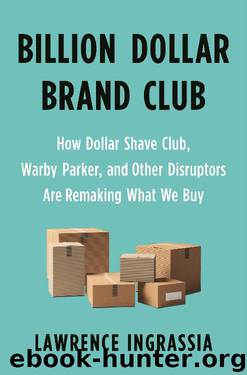Billion Dollar Brand Club by Lawrence Ingrassia

Author:Lawrence Ingrassia [Lawrence Ingrassia]
Language: eng
Format: epub
Publisher: Henry Holt and Co.
Published: 0101-01-01T00:00:00+00:00
9
The Mattress Wars
Walk into just about any mattress store in America. Gaze around the showroom. Take a deep breath. You are about to embark on one of the most befuddling and irritating shopping experiences you will ever encounter—one that makes buying a car look easy and pleasant.
You may have tried to prepare by first doing some research online, but that is unlikely to help. That’s because you are going to be presented with a deliberately confusing overabundance of choices.
At the Sit ’n Sleep in a strip mall in Culver City, California, 134 mattresses are on offer, with prices ranging from $500 to $11,000. There’s the Sealy Premium Joy King for $993.99, the Serta Perfect Sleeper Sandalwood model for $1,382.99, the Serta Blue Fusion 1000 LF King for $2,659.99, the Aireloom Laguna PL King for $5,978.94, the Tempur-Contour Elite Breeze Split/Dual California King for $7,598, and the Tempur-Ergo Premier for $11,396. And on and on. Oh, and if you don’t like the mattress—because you only had a few minutes to lie down on it in the store, when you really need to sleep on a mattress for at least a few nights to know if it’s right for you—forget about getting your money back. Sit ’n Sleep allows you only to exchange the mattress for a different one, and doing so will cost you a 20 percent “restocking” fee.
You say you want to compare the prices with any of a half dozen mattress stores within a fifteen-minute drive, or with the prices you saw while doing research online? Well, good luck with that. The other retailers carry many of the same mattresses from the same manufacturers, but they likely will have different names. The confusion is by design, because retailers, whose salespeople work on commission, don’t want you to be able to compare prices. And Serta Simmons and Tempur-Sealy, the two companies that have long controlled about 70 percent of the U.S. mattress market, which is roughly split evenly between them, have been happy to cooperate. It’s a very comfortable relationship, one designed to maximize profits for the manufacturers and retailers, and earnings for the commissioned salespeople, who can do very well selling just a couple of mattresses a day.
It was at a mattress store in the San Francisco Bay Area that John-Thomas “JT” Marino and his wife bought a Tempur-Pedic foam mattress in 2010 for more than $3,000. For Marino, a recent math and computer science graduate of Penn State University, the mattress was one of the most expensive purchases he had ever made. He recalls trekking to several stores and trying to compare prices but finding it impossible. Then he had to take two days off work waiting for the mattress to arrive, because the delivery crew didn’t show up on the scheduled day. “It was a nightmare, one of the worst experiences of my life,” says Marino. And he and his wife didn’t even like the mattress after sleeping on it, but they kept it because of the store’s onerous return policy.
Download
This site does not store any files on its server. We only index and link to content provided by other sites. Please contact the content providers to delete copyright contents if any and email us, we'll remove relevant links or contents immediately.
| Private Equity | Valuation |
| Venture Capital |
The Black Swan by Nassim Nicholas Taleb(7009)
Bad Blood by John Carreyrou(6543)
Pioneering Portfolio Management by David F. Swensen(6226)
Millionaire: The Philanderer, Gambler, and Duelist Who Invented Modern Finance by Janet Gleeson(4374)
Skin in the Game by Nassim Nicholas Taleb(4161)
Bullshit Jobs by David Graeber(4094)
The Money Culture by Michael Lewis(4073)
Skin in the Game: Hidden Asymmetries in Daily Life by Nassim Nicholas Taleb(3929)
The Wisdom of Finance by Mihir Desai(3649)
Blockchain Basics by Daniel Drescher(3495)
Liar's Poker by Michael Lewis(3367)
Fooled by Randomness: The Hidden Role of Chance in Life and in the Markets by Nassim Nicholas Taleb(3043)
Hands-On Machine Learning for Algorithmic Trading by Stefan Jansen(3026)
The Intelligent Investor by Benjamin Graham Jason Zweig(2995)
Mastering Bitcoin: Programming the Open Blockchain by Andreas M. Antonopoulos(2980)
The Power of Broke by Daymond John(2895)
Investing For Dummies by Eric Tyson(2893)
Market Wizards by Jack D. Schwager(2643)
Zero Hour by Harry S. Dent Jr. & Andrew Pancholi(2614)
